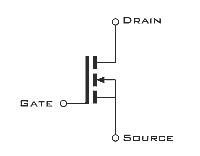It is a single ended design guys... caps will have to be in the signal path....
Regardless of the opamp, C3 MUST and I repeat *MUST* be there unless your cans like 5-10 volts across them. Again, this is a single ended design... there is no chance for voltage cancellation that would negate the voltage and make it can-friendly. C2 should probably also be there to make sure the gate is DC-free... which may matter depending on how the MOSFET is biased. C1 at the opamp could be omitted, I suppose, since amplified DC from the opamp will be blocked by C2 before it reaches the MOSFET.
Include feedback? You could do this... Sheldon Stokes does this in his SDS amp... but notice his push-pull output stage. That is why he manages no output cap. The inverted voltage from one MOSFET effectively cancels the voltage of the other across the headphones.
BTW- nothing wrong with P-channel, though most like N-channel MOSFETs better. The way it is wired now, you are taking the output signal from the MOSFET's drain, which will give you voltage and current gain. I am guessing this is what you were going for in selecting the P-channel FET. Nelson Pass does this in his amps, and I usually try to in my work with MOSFETs.
Don't worry about the JFET up front... the opamp has a low enough output impedence that there should not have any adverse effects from driving it direct without a JFET buffer. The JFET was added because the original Szekeres design, which used a single N-channel MOSFET providing current-gain only, was intended to be driven directly by a 10k volume pot from the source... no preamp/opamp involved in between. By using this opamp, you eliminate the high-frequency roll-off problems associated with driving the high gate-capacitance FET with a high-impedence source.
I sort of agree with using a constant current source... but disagree with LM317 after having read about it. It is basically another IC... and being the Zen-minded parts minimalist I am, I do NOT like IC's in the signal path anymore. Why use an IC with 5+ gain stages when one will do? You could use another MOSFET as the current source, but a high power resistor would do just fine, really.
On another note, you may check out
Marcello Pellerano's Zen amp, which is a scaled down model of Nelson Pass's Zen amp. It utilizes a constant current source that varies based upon the load... and also uses a N-channel device wired for voltage and current gain, as your is. If you require more voltage gain, you can add a simple N-channel FET buffer up front wired for voltage gain and you will get plenty of power to drive any cans.
Another thing to consider... you might look into some of Neslon Pass's documents about his amps. You could use the Son of Zen or X-Son of Zen design to eliminate output caps. His Zen variation 5 (push-pull complimentary) would also do this. Then you don't have to worry about those nasty electrolytics in the signal path (not actually so bad, though, really... and I hate caps in signal path).
If you want more MOSFET ideas, look at these:
Zen headphone amp
Szekeres
Murdey amp
Newer Zen variations
Older Zen variations
(note: amp designs found with last two links probably MUST be modified for headphone use)
And, check out the
DIYAudio Forums Pass Labs section for more help.










